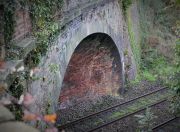Rewe Skew Bridge: Difference between revisions
Created page with "William Froude is generally credited with the design of this skewed arch bridge. The angle of skew is approximately 52 degrees. Froude built a similar bridge 5 miles to..." |
No edit summary |
||
| Line 1: | Line 1: | ||
[[image:JD 2021 Rewe 1.jpg|thumb|2021]] | |||
[[William Froude]] is generally credited with the design of this skewed arch bridge. The angle of skew is approximately 52 degrees. Froude built a similar bridge 5 miles to the south, with a slightly smaller amount of skew. See [[Cowley Bridges, Exeter|Cowley Bridge, Exeter]]. The arches of these two bridges embody Froude's unusual form of construction. The brickwork is considerably more complex than in the more common helicoidal design, with the aim of having all the courses of bricks meeting the faces of the arch at right angles. This required the first two or three bricks in each course to be tapered. The bricklayers' opinions are not recorded. | [[William Froude]] is generally credited with the design of this skewed arch bridge. The angle of skew is approximately 52 degrees. Froude built a similar bridge 5 miles to the south, with a slightly smaller amount of skew. See [[Cowley Bridges, Exeter|Cowley Bridge, Exeter]]. The arches of these two bridges embody Froude's unusual form of construction. The brickwork is considerably more complex than in the more common helicoidal design, with the aim of having all the courses of bricks meeting the faces of the arch at right angles. This required the first two or three bricks in each course to be tapered. The bricklayers' opinions are not recorded. | ||
Revision as of 16:41, 9 December 2021

William Froude is generally credited with the design of this skewed arch bridge. The angle of skew is approximately 52 degrees. Froude built a similar bridge 5 miles to the south, with a slightly smaller amount of skew. See Cowley Bridge, Exeter. The arches of these two bridges embody Froude's unusual form of construction. The brickwork is considerably more complex than in the more common helicoidal design, with the aim of having all the courses of bricks meeting the faces of the arch at right angles. This required the first two or three bricks in each course to be tapered. The bricklayers' opinions are not recorded.

